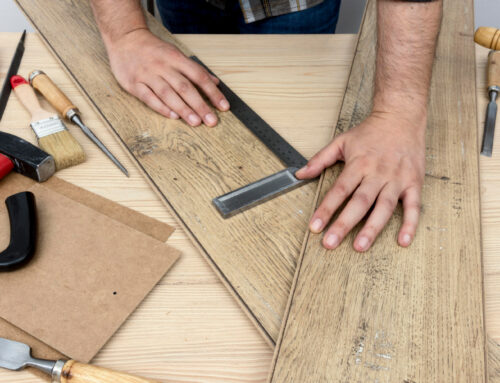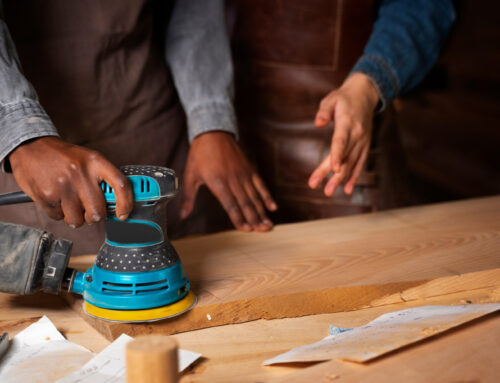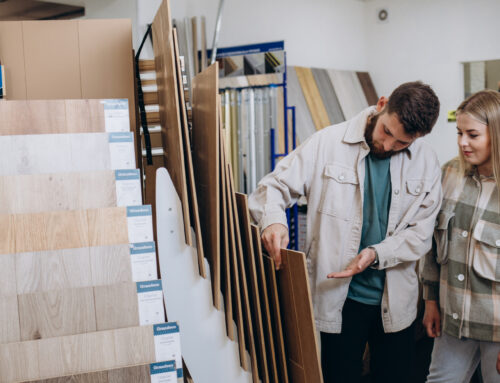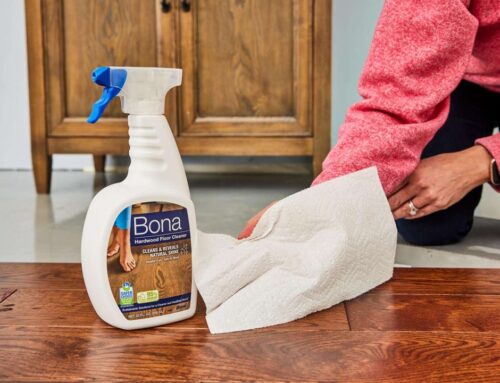The best wood floor cleaner liquid uses pH-neutral, non-toxic formulas that clean without damaging the wood finish. Premium cleaners like Bona, Loba, and Pallmann remove dirt and grime while preserving your floor’s protective coating for years of lasting beauty.
Choosing the wrong cleaner strips the finish, leaves residue, or causes dullness that makes your beautiful hardwood look worn and neglected. The right liquid cleaner maintains your floor’s luster while protecting the wood underneath from moisture damage.
Your hardwood floors represent a significant investment in your home’s beauty and value. Protecting that investment starts with using cleaners specifically formulated for wood rather than generic products that promise to clean everything.
Why the Right Cleaner Matters for Hardwood Floors?
Using improper cleaning products accelerates finish breakdown and can void manufacturer warranties. Hardwood-specific cleaners maintain the delicate balance between removing dirt and preserving the protective finish layer.
How Liquids Affect Wood Finish and Longevity?
Liquid cleaners interact directly with your floor’s finish layer, which protects the wood from moisture, scratches, and UV damage. pH-balanced formulas clean effectively without breaking down this protective barrier.
Alkaline cleaners with a pH above 9 soften and gradually dissolve polyurethane finishes. This creates a dull appearance and leaves wood vulnerable to water damage. Acidic cleaners below pH 6 can etch and damage certain finish types.
The finish acts as a sealed barrier between wood and moisture. When cleaners compromise this barrier, water penetrates into the wood grain, causing swelling and cupping. Dirt embeds into exposed wood rather than sitting on the finish surface. Color changes occur as moisture reacts with wood tannins, and refinishing becomes necessary years earlier than expected.
Pro Tip:
Always check your floor’s finish type before selecting a cleaner. Oil-finished floors need different products than polyurethane-finished floors. Using the wrong type can create problems even if the cleaner is high quality.
Common Cleaning Mistakes to Avoid
The most common mistake is using too much water or liquid cleaner. Excess moisture seeps between planks and damages wood from below, causing warping and finish delamination.
Damaging cleaning practices to avoid:
- Using vinegar, which is acidic and etches polyurethane finishes over time
- Applying all-purpose cleaners containing ammonia or harsh detergents that damage floors
- Steam mopping, which forces moisture and heat into the wood grain
- Skipping dust removal before mopping that scratches the finish with abrasive particles
- Using dirty mop water that redistributes grime across your floor
Many people believe natural means safe, leading them to use lemon juice, baking soda, or vinegar solutions. These DIY mixtures have incorrect pH levels and cause cumulative damage with repeated use.
What to Look For in a Hardwood Floor Cleaner Liquid?
The best wood floor cleaner liquid contains specific ingredients that lift dirt without leaving residue or damaging protective finishes. Understanding label claims helps you choose products that deliver on their promises.
Importance of pH-Neutral and Non-Toxic Formulas
pH-neutral cleaners (pH 7–8) safely clean all hardwood finishes while preserving the protective coating.
Non-toxic formulas protect your family and pets from harmful chemical exposure. Many conventional cleaners contain volatile organic compounds (VOCs) that off-gas into your home’s air, causing respiratory irritation and long-term health concerns.
Look for certifications on cleaner labels like GREENGUARD certified, which confirms low chemical emissions, EPA Safer Choice indicating safer ingredients for families and the environment, biodegradable, ensuring environmental responsibility, and no VOCs, meaning no harmful fumes during or after cleaning. pH-neutral cleaners lift dirt gently without harming the wood finish. This mechanical cleaning action proves gentler and more sustainable than harsh chemical cleaners.
Ingredients That Protect Versus Ingredients to Avoid
Protective ingredients in quality hardwood cleaners include plant-based surfactants, natural chelating agents, and water softening compounds. These ingredients clean thoroughly while leaving no harmful residue.
Beneficial ingredients:
- Plant-derived surfactants break surface tension to lift dirt
- Citric acid, in controlled amounts, provides gentle cleaning without harming finishes.
- Glycerin conditions wood and prevents drying
- Deionized water prevents mineral deposits and streaking
Ingredients to avoid:
- Ammonia strips finish and create dull spots
- Bleach discolors wood and degrades finish polymers
- Oil soap builds up residue that attracts dirt
- Wax creates a buildup requiring stripping
- Petroleum distillates damage the finish and create health hazards
Ammonia-based cleaners remain popular because they cut grease effectively, but this same cutting action removes your floor’s protective finish. The temporary shine from oil soaps comes from residue buildup, not clean floors.
Scent, Ease of Use, and Compatibility with Modern Wood Finishes
Fragrance-free or naturally scented cleaners prevent allergic reactions and respiratory irritation. Artificial fragrances contain chemicals that linger in your home long after cleaning.
Ready-to-use formulas eliminate mixing mistakes and provide consistent results. Concentrated products offer value but require precise dilution ratios to avoid damaging your floors with too strong or too weak solutions.
Modern polyurethane, aluminum oxide, and UV-cured finishes require cleaners specifically formulated for synthetic coatings. Oil-finished floors need cleaners that don’t strip the oil or leave incompatible residue.
Smart Hack:
Test any new cleaner in an inconspicuous area first. Apply a small amount, let it dry completely, and check for cloudiness, discoloration, or sticky residue before cleaning your entire floor.
Top Liquid Wood Floor Cleaner Options
Professional-grade cleaners used by flooring contractors deliver superior results compared to grocery store products. These specialized formulas protect your investment while providing exceptional cleaning power.
Bona Hardwood Floor Cleaner
Bona Hardwood Floor Cleaner stands as the industry standard with a pH-neutral, residue-free formula trusted by professionals worldwide. This ready-to-use spray cleaner works on all polyurethane-finished hardwood without dulling or buildup.
Bona advantages include:
- GREENGUARD Gold certified for indoor air quality
- Safe for pets and children once dry
- Quick-drying formula prevents water damage
- Works with spray mops for easy application
- No rinsing required
Arboritec Hardwood Floor Cleaner
Arboritec Hardwood Floor Cleaner provides professional strength cleaning with an advanced formulation that cuts through dirt without harming the finish. This versatile cleaner works beautifully on both residential and commercial hardwood floors.
Arboritec features include:
- pH-balanced formula safe for all polyurethane finishes
- Available in convenient 1-gallon premixed bottles
- Professional contractor favorite for daily maintenance
- Biodegradable and environmentally responsible
- Streak-free performance with proper application
Glitsa Cleaner Gallon
Glitsa Cleaner Gallon offers commercial-grade cleaning power for high-traffic areas and demanding applications. This concentrated formula delivers exceptional results while protecting your floor’s finish.
Glitsa benefits include:
- Professional strength for heavy-duty cleaning
- Works on both residential and commercial installations
- Gallon size provides excellent value for larger homes
- Trusted by flooring contractors nationwide
- Safe for use with Glitsa finish systems
Rubio Monocoat Universal Soap
Rubio Monocoat Universal Soap maintains and cleans oil-finished floors while refreshing the protective layer. This unique soap-based cleaner works differently than traditional cleaners, actually nourishing the wood while cleaning.
Rubio Monocoat distinguishes itself with:
- Specially formulated for oil-finished hardwood
- Cleans while maintaining the oil finish
- Natural ingredients from renewable resources
- Extends the time between floor re-oiling
- Creates a subtle protective layer with each use
Arboritec Clean n’ Coat
Arboritec Clean n’ Coat serves as a deep cleaning solution that prepares floors for recoating. This specialty product removes built-up grime and slightly softens existing finish to help new coatings bond perfectly.
Clean n’ Coat excels at:
- Deep cleaning before refinishing or recoating
- Removes stubborn buildup that other cleaners leave behind
- Prepares surface for optimal coating adhesion
- Professional-grade results for serious floor care
- Essential for floor restoration projects
Want to transform your floor cleaning routine with these products professionals trust?
Rustic Wood Floor Supply offers these premium hardwood cleaners. Our flooring experts help you match the perfect cleaner to your specific floor finish and lifestyle needs.
Browse Cleaning Supplies: (678) 691-0533
How to Safely Clean Your Hardwood Floors?
Proper cleaning technique matters as much as choosing the best wood floor cleaner liquid. Following correct procedures prevents damage while maximizing cleaner effectiveness. Many homeowners use excellent products but apply them incorrectly, negating their benefits. Simple technique adjustments dramatically improve results.
Prepping Your Floor: When to Sweep, Mop, or Dust First
Always remove loose dirt and debris before wet cleaning. Grit and particles act like sandpaper when dragged across your floor by a mop, creating micro scratches that dull the finish over time.
Daily preparation includes:
- Sweeping with a soft-bristle broom in high traffic areas
- Vacuuming using a hardwood floor attachment without a beater bar
- Using a microfiber dust mop for quick touch-ups
- Removing shoes at entry points to prevent tracked-in dirt
Weekly preparation:
- Thorough vacuum of the entire floor, including edges
- Check for stuck-on debris requiring spot treatment
- Move area rugs to clean underneath
- Vacuum heating vents and floor registers
Microfiber tools trap particles rather than pushing them around. Traditional brooms scatter fine dust that settles back onto your floor within minutes.
Step-by-Step Cleaning Instructions Using Liquid Cleaner
Following manufacturer instructions ensures optimal results while protecting your floor. Each cleaner has specific application methods that maximize effectiveness.
Cleaning process:
- Remove all loose dirt through sweeping or vacuuming
- Spray cleaner directly on the floor or apply to a damp mop
- Work in 4-foot by 4-foot sections to prevent the cleaner from drying
- Use figure eight motion with light pressure
- Flip or rinse mop head frequently to avoid redistributing dirt
- Allow the floor to air dry completely before walking on it
Wring out your mop until it’s just barely damp rather than wet. You should see moisture on the floor, but it should dry within 2 to 3 minutes. If water sits on the surface longer, you’re using too much liquid.
Never pour cleaner directly onto large areas of floor. This creates puddles that can seep between planks and cause swelling. Spray application or damp mopping provides adequate moisture without flooding risk.
Work backward from the far corners toward your exit so you never walk on freshly cleaned areas. Footprints on wet floors transfer body oils that leave marks requiring re-cleaning.
Tips for Fast Drying and Zero Residue
Proper cleaner dilution and application technique prevent residue and speed drying. Residue indicates either too much cleaner or insufficient moisture removal during mopping.
Fast drying techniques:
- Use a damp mop with minimal water
- Increase air circulation with ceiling fans
- Open windows on low-humidity days
- Clean during warm parts of the day when the air holds more moisture
- Use microfiber mops that release less water than cotton
Residue prevention:
- Follow dilution ratios precisely for concentrated cleaners
- Rinse the mop frequently during cleaning
- Change the cleaning solution when it becomes visibly dirty
- Avoid using expired cleaners that separate or degrade
- Use the recommended amount per square footage
Residue appears as dull patches, sticky spots, or cloudy film. If you experience residue despite following instructions, the cleaner may not suit your specific finish type. Switch to a different formula recommended for your floor.
Maintaining Floor Beauty and Finish Over Time
Consistent maintenance keeps hardwood looking new for decades. Establishing simple routines prevents damage before it occurs rather than trying to fix problems later.
Frequency of Cleaning: Daily, Weekly, and Deep Cleaning
Different areas of your home require different cleaning frequencies based on traffic and use patterns. High traffic zones need more frequent attention than bedrooms or formal spaces.
Daily maintenance:
- Sweep or vacuum entryways and kitchen floors
- Spot clean spills immediately with a damp cloth
- Place mats at exterior doors
- Remove shoes to prevent outdoor dirt transfer
Weekly cleaning:
- Full floor vacuuming or dust mopping
- Damp mop with hardwood cleaner in the main living areas
- Check for and address any new damage or wear
- Clean under furniture and in corners
Monthly deep cleaning:
- Move all furniture and area rugs
- Clean the entire floor surface with a quality cleaner
- Address any sticky spots or stubborn stains
- Inspect the floor for needed repairs or finish touch-up
Kitchens and entryways typically need cleaning two to three times weekly due to higher traffic and exposure to food, moisture, and outdoor debris. Bedrooms and formal dining rooms may only need weekly or biweekly cleaning.
How to Address Spills, Stains, and Sticky Spots?
Immediate spill cleanup prevents stains and water damage. Most stains that seem permanent could have been prevented with quick action after the spill occurred.
Spill response:
- Blot liquid immediately with an absorbent cloth (don’t wipe)
- Clean the area with a small amount of hardwood cleaner
- Dry thoroughly with a clean towel
- Avoid letting any liquid sit on the floor surface
Sticky spot removal:
- Apply a small amount of hardwood cleaner to a cloth
- Gently rub the sticky area using a circular motion
- Wipe clean with a barely damp cloth
- Dry the area completely
Stubborn stain treatment:
- Identify stain type (water, oil, pet, etc.)
- Use an appropriate specialty cleaner for the stain type
- Follow product instructions carefully
- Test in the hidden area first
- Consider professional help for valuable floors with serious staining
Water stains indicate moisture penetrated the finish and reacted with wood tannins. These may require professional buffing or recoating to remove completely.
Pro Tip:
Keep a dedicated spill cleanup kit near your kitchen and dining areas. Include microfiber cloths, your regular hardwood cleaner, and paper towels for quick response to accidents before they become permanent stains.
When to Refresh or Recoat for Maximum Gloss and Protection?
Recoating adds a fresh finish layer without full sanding, extending your floor’s life by another 5 to 10 years. This process costs far less than complete refinishing.
Signs your floor needs recoating include:
- Widespread dullness that cleaning doesn’t improve
- Worn traffic patterns showing bare wood
- Water no longer beads on the surface
- Increased scratch visibility
- Uneven sheen across the floor surface
Most polyurethane finished floors need recoating every 7 to 10 years with proper maintenance. Oil-finished floors require re-oiling every 1 to 2 years, depending on traffic.
Screen and recoat involves lightly abrading the existing finish, then applying fresh polyurethane. This process typically costs one-third of complete refinishing while restoring it to a like-new appearance.
Choosing the Best Cleaner for Your Needs
Matching a cleaner to the finish type and household conditions ensures optimal results. A cleaner that works beautifully on your neighbor’s floor might damage yours if the finish types differ. Understanding your specific needs helps narrow options to products that deliver results you’ll love.
Match Your Cleaner to Your Floor’s Finish and Lifestyle
Different finish types require specifically formulated cleaners. Using the wrong product can strip protective layers or create buildup problems.
- Polyurethane finishes need pH-neutral cleaners without oil or wax. Products like Bona Hardwood Floor Cleaner and Pallmann Clean work perfectly for these most common finishes.
- Oil and wax finishes require specialty cleaners that maintain oil content while cleaning. Loba Parkett Care and Woca Wood Floor Soap provide cleaning and maintenance simultaneously.
- UV-cured and aluminum oxide finishes need gentle, residue-free cleaners that won’t interfere with these extremely hard coatings. Most professional pH-neutral cleaners work well.
Lifestyle factors influence cleaner choice. Homes with pets benefit from cleaners with odor-neutralizing properties. Families with children need non-toxic formulas safe for crawling babies. High-traffic homes require heavy-duty options like Basic Coatings Squeaky. Allergy sufferers need fragrance-free, low-VOC products.
Bottom Line
Protecting your hardwood floors starts with choosing the best wood floor cleaner liquid formulated specifically for wood finishes. pH-neutral, non-toxic formulas clean effectively while preserving the protective finish that keeps your floors beautiful for decades.
Avoid common mistakes like using vinegar, ammonia cleaners, or excess water. Invest in professional-grade products designed and tested specifically for hardwood. The minimal cost difference between quality cleaners and generic products pales compared to the value of your flooring investment.
Rustic Wood Floor Supply makes protecting your hardwood floors simple by offering professional-grade, pH-neutral cleaners and expert guidance. Whether you’re maintaining daily shine or tackling tough stains, their products are designed specifically for all wood finishes, helping you preserve your floors’ beauty and longevity. With us, investing in quality cleaners means investing in the life and value of your floors.
Frequently Asked Questions
Can I use a general-purpose cleaner, or must it be pH-balanced?
General-purpose cleaners contain harsh chemicals that gradually damage the hardwood finish. pH-balanced cleaners specifically formulated for hardwood protect your investment while cleaning effectively. Multi-surface products may seem convenient, but they compromise floor longevity and void manufacturer warranties.
Is it safe to use water, vinegar, or soap on hardwood?
Plain water used sparingly with quick drying is safe. Vinegar’s acidity etches polyurethane finishes over time. Dish soap leaves residue that attracts dirt. Use cleaners specifically designed for hardwood to avoid damage while achieving superior cleaning results without risk.
Will professional floor cleaners help with pet stains or tracked-in dirt?
Yes, professional hardwood cleaners effectively remove pet stains and tracked dirt without damaging the finish. Products like Basic Coatings Squeaky handle heavy-duty cleaning while protecting wood. For biological stains, address quickly and use enzyme cleaners before applying hardwood safe finishing cleaner.
Which type is best for matte vs. glossy wood floors?
Both matte and glossy floors use the same pH-neutral cleaners. Matte finishes show fewer streaks and water marks. Glossy finishes require thorough drying and minimal product to prevent streaking. Follow manufacturer recommendations rather than choosing based on the sheen level alone for best results.
How much cleaner is needed to avoid streaks or film?
Use 1 to 2 sprays per 4-foot section for ready-to-use products. For concentrated cleaners, follow label dilution ratios precisely. Less is more with hardwood cleaners. Excess product causes streaking and residue. Your mop should be damp, not wet, when cleaning.
Author Profile
- I have worked in hardwood flooring for the last 8 years. Use to run a company of residential crews as well as a company with gym flooring. If you need floor installation or refinishing help, I should have an answer or at least get you in the right direction.
Latest entries
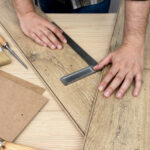 FlooringNovember 25, 2025What Engineered Hardwood Flooring Will Last Longest?
FlooringNovember 25, 2025What Engineered Hardwood Flooring Will Last Longest?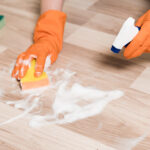 FlooringNovember 22, 2025Best Wood Floor Cleaner Liquid for Hardwood Flooring
FlooringNovember 22, 2025Best Wood Floor Cleaner Liquid for Hardwood Flooring FlooringNovember 17, 2025Best Sanding Machine For Hardwood Flooring
FlooringNovember 17, 2025Best Sanding Machine For Hardwood Flooring FlooringNovember 10, 2025Local Wholesale Flooring Services Boise, Idaho
FlooringNovember 10, 2025Local Wholesale Flooring Services Boise, Idaho

